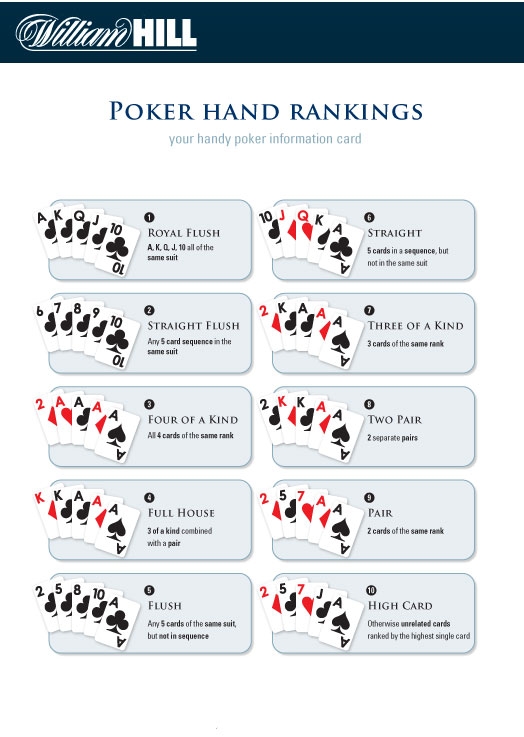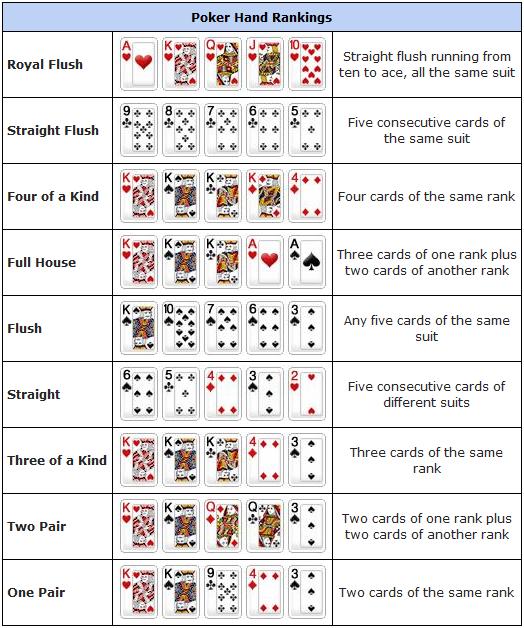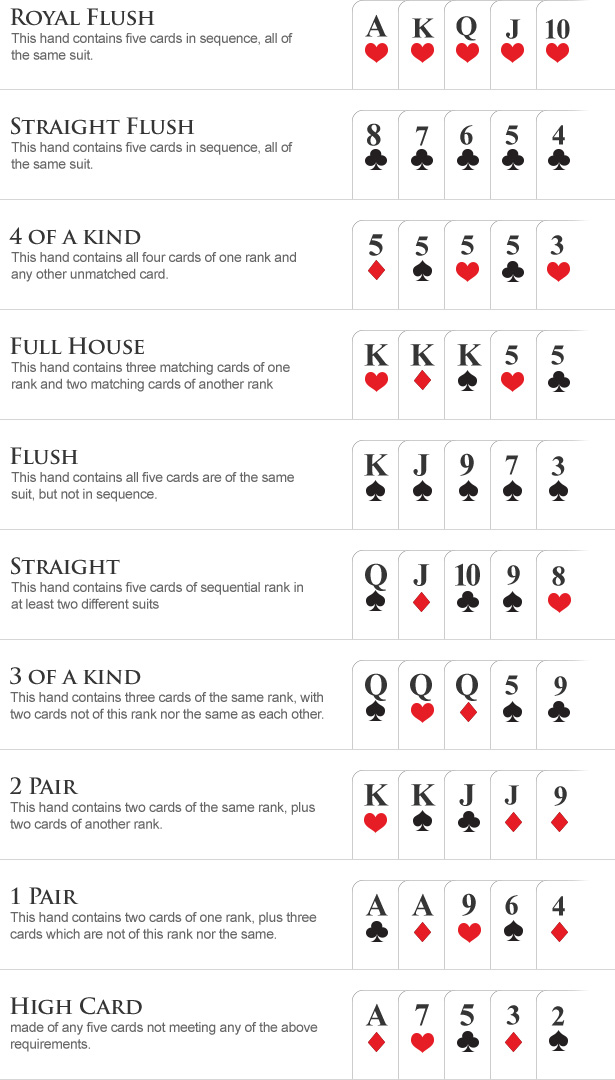Suit Strength Texas Holdem
This poker hand ranking chart for beginner poker players is easy to study. It should be used as a resource to find out who wins a poker hand showdown. Beginning poker players often get confused about poker hand rankings and who wins in some situations.
A - The player who creates a straight with the highest cards in value wins the pot. For example, in a Hold’em game, player A has J-K, Player B is holding 7-8, and the board comes 10-Q-9-6-3. In this situation, player A with 9-10-J-Q-K beats Player B with 6-7-8-9-10. Q - Who wins if two players are holding a full house? Texas Hold’em: a game in which it is easy to learn the basics, but considerably harder to master. For now, let's cover a basic part of the game - starting hands.
Poker Hand Suits – From Best to Worst
In the event of a tie, most poker hand ranking charts award the player with the highest suit the pot. The suit strength is based on the first letter of the suit. This is not true for Texas Hold em. If there is a tie in Texas Holdem the pot is split into equal portions and distributed equally amongst the winners.
- Spades
- Hearts
- Diamonds
- Clubs
Poker Hand Ranking Chart – From Best to Worst
The official poker hand ranking chart can be found below. The strongest hand in a five card poker game is always a royal flush, unless the poker game is being played as a lowball game or a split pot game with an 8 or better qualifier. Those games are not something that you need to understand this early in your poker career. For now, lets just focus on the poker hand ranking chart and the strength of hands in comparison to each other.
Royal Flush – 1 in 649,740.00
A royal flush is an ace, king, queen, jack, and a ten which are all the same suit. There is only one combination of this hand and it is the rarest of all poker hands.
Royal Flush Ties
Split the pot amongst people who have a royal flush.
Straight Flush – 1 in 72,193.33
A straight flush consists of five cards in sequential order and of the same suit.
Straight Flush Ties
The person with the highest rank card at the top of the sequence wins.
Four of a Kind – 1 in 4,165.00
Four of a kind is four of the same rank card and another card.
Four of a Kind Ties

Highest rank four of a kind wins. In community games, the highest fifth card (kicker) determines the winner.
Full House – 1 in 694.16
A full house is three cards of the same rank and two different cards of a matching rank.
Full House Ties
The higher three card rank wins. In the event that this is the same, the higher two card rank wins.
Flush – 1 in 508.80

A flush is five cards of the same suit.
Flush Ties
The highest ranked card wins. If necessary, the second-highest, third-highest, forth-highest, and fifth-highest ranked card may be used to break a tie.
Straight – 1 in 254.80

A straight is five cards in sequential order.
Straight Ties
The highest ranked card at the top of the sequence wins.
Three of a Kind – 1 in 47.32
Three of a Kind is three cards of the same rank and two side cards.
Three of a Kind Ties
Higher ranked three of a kind wins. If necessary, the highest and second-highest ranked side card may be used.
Two Pair – 1 in 21.03
Two pair is two matching cards of one rank and two of a different matching rank, along with a side card.
Two Pair Ties
Highest matching pair wins, if this is the same then second-highest matching pair wins. In the event of both pairs matching, the side card (kicker) determines the winner.

One Pair – 1 in 2.36
Online Texas Holdem
A pair is two matching cards of the same rank and three unrelated side cards. Having one pair is more powerful than having no pair.
One Pair Ties
Highest pair wins, if players share the same pair, highest side card wins. If necessary, use the second-highest and third-highest side cards.
High Card – 1 in 1.99
High card is any hand that does not qualify for the above hands.
High Card Ties
Highest card wins. If necessary, use second-highest, third-highest, forth highest, and fifth highest cards to determine the winner.
Additional Poker Hand Ranking Chart Resources
We surely are not the only ones with a poker hand ranking chart. In fact, the world’s best social resource, Wikipedia, has created their very own poker hand ranking permutations that are go to extreme depths to explain how they reached each calculation. Go to the Wikipedia’s poker probability page now…
Printable Poker Hand Rank Chart
Here is a printable poker hand ranking chart for you to take with you. If you reduce its size, or fold the paper you print it on, you can take it with you on the go. This poker rank list will be helpful for playing your first time in a live casino or card room.
Suit Strength Texas Hold'em
To print the hand ranking chart, simply click the image below and print the page it brings you to.
There are quite a few poker variations out there, but Texas Hold’em poker is one of the more popular ones to play, especially in high-stakes tournaments and casinos. In fact, when we say poker, we’re usually referring to Texas Hold’em poker specifically, or the lesser-played five-card stud. Despite this, many versions follow the same hand values as Texas Hold’em poker.
Why are hand strengths important to know? Well, if you’re new to the game, it’s vital you memorize the order of hands so you know when to bet. Hand strength dictates your probability of winning, even when you have no hand at all. Let’s take a look at the hand strengths for Texas hold’em poker from best to worst!
Royal Flush
This hand is so rare you probably will never see it in person. In fact, your chance of getting a royal flush in any given hand is .00001%. Why’s it so rare? It’s the highest cards: A, K, Q, J, 10 in any of the four suits, meaning there are only four ways to get it. It’s also the best hand in poker, so if you are one of the lucky few, you’re going to win the round.
Straight Flush
The straight flush is like a royal flush, but with any other five cards in sequential order and the same suit. A good example would be K, Q, J, 10, 9 in any of the same suit. Remember that the higher the combination of cards, the better the hand is.
Four of a Kind
This hand is what it sounds like: four of the same card. Also very rare because you would need all four cards in the deck. Think four 10s, four Jacks, and so on.
Full House
Here’s where the hands start to get more common. A full house is 2 of one kind (any suit) and 3 of another (any suit). So a combination would be 2 5’s and 3 Aces. The higher the combination, the better the full house is. Full Houses are ranked by their triplet pairs first, then their doubles. If they just differ in suit, then they are equally ranked.
Flush
A flush is five cards in any numerical order, but they all have the same suit. So five cards that are diamond, or five that are hearts. It doesn’t count if you only have four, so be careful not to risk too much if you’re missing a card for a flush.
Straight
Right below a flush is a straight. These are cards in sequential order, but not the same suit. 2,3,4,5,6 (6-high) is the lowest form of straight, so that hand would lose to a 3,4,5,6,7 (7-high) straight.
Three of a Kind
This one is pretty straightforward: three of the same number. J, J, J, etc. They do not have to be the same suit (and can’t be unless you use multiple decks).
Two Pair
A two pair is two sets of the same numbers. J, J, 10, 10 is a good example. This is a really common type of hand, as the probability to get it is fairly good. The numbers don’t have to match suits.
Pair
This is the second lowest hand: two of the same number. A, A is the highest pair you can have.
High Card
When all else fails, the highest card wins. Even if you don’t have a great hand, your high card is important, and has decided many matches. Your high card is ALWAYS in play, so even if you have a great hand, remember that if someone matches your hand strength, the high card will decide the winner. Keep this in mind, because it happens a lot.
Now that you know the basic hand strengths in Texas Hold’em poker, you’re ready to start playing! Try playing without betting first so you get a feel for the game without the pressure of tossing chips away. Good luck! See more how-tos over at our blog!
